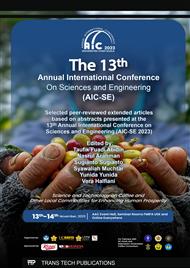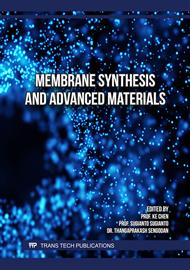p.29
p.41
p.53
p.61
p.69
p.81
p.91
p.97
p.103
Applying Box-Behnken Experimental Design for Optimization of Polyurethane Membrane Synthesis from Castor Oil (Ricinus communis L.) Based on Physical Performance
Abstract:
The process of synthesizing polyurethane (PU) membranes typically involves linking together networks of polymers using organic materials like polyols and isocyanates. Subsequent investigations used additional inorganic substances within PU polymers to enhance the mechanical and thermal characteristics of membranes. In order to be used as a sensor matrix, the PU membrane needs to have certain good qualities and be able to firmly attach to ions. Hence, further refinement of the membrane is necessary in order to enhance these attributes. The PU membrane made from castor oil (Ricinus communis L.) was changed in this study by adding ĸ-carrageenan and D2EHPA. The composition of the membrane plays a crucial role in governing the creation of hard and soft segments within the membrane structure. The right membrane composition can be found by using Expert Version 13 software for process design. This software is based on the Response Surface Methodology and uses Box-Behnken Design. The primary aim of this study was to fabricate PU membranes utilizing natural resources while ensuring the attainment of desirable qualities. The R2 and PRESS values, which are very important for figuring out how important the physical performance response is, led to the choice of the quadratic model design as the best one. One of the experimental conditions was the use of 0.231 mg of D2EHPA, 1.241 mg of κ-carrageenan, and 3.840 g of acetone. The final mixture was predicted to have a visual scale value of 6.5 so that a membrane with the best physical properties in terms of strength and flexibility could be made. The composite-derived PU membrane has favorable physical performance. The findings of this study can serve as a foundational element for the advancement of PU membranes in a wide range of prospective applications.
Info:
Periodical:
Pages:
69-77
Citation:
Online since:
December 2024
Authors:
Price:
Сopyright:
© 2024 Trans Tech Publications Ltd. All Rights Reserved
Share:
Citation:



